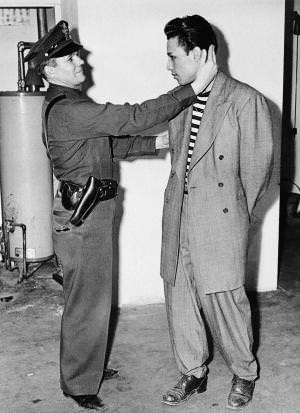From Flappers to Hipsters
100 years of mesmerizing, terrifying, cringe-inducing youth icons.


If youth is wasted on the young (and it is!), it's also a constant source of desire and anxiety in American society.
There's virtually no social panic or cultural love affair like the ones about the kids these days, whether it's fear of fawning over flappers; hating on or hailing hippies; or freaking out or rhapsodizing over ravers. Millennials and even-younger kids are dismissed as a narcissistic "Generation Selfie" that is dangerously self-obsessed. At least when they are not being praised as independent and individualistic.
Here's a quick tour of a century's worth of mesmerizing, terrifying, cringe-inducing youth icons. The list is incomplete, so please add in the comments section your favorite youth icons that got the cold shoulder.

Flappers (1920s). Flappers were young women with short hair, boyish figures, and a devil-may-care attitude toward social etiquette and conventional gender roles. They were supposed to be sexually liberated too. The first use of the term comes from a 1920 movie starring Olive Thomas, who died in one of Hollywood's first big press scandals. Popularized by writers such as F. Scott Fitzgerald, flappers were also considered dangerous dimwits. As Wikipedia notes, "The secretary of labor denounced the 'flippancy of the cigarette smoking, cocktail-drinking flapper.' A Harvard psychologist reported that flappers had 'the lowest degree of intelligence' and constituted 'a hopeless problem for educators.'"
Next: Zoot-Suit Brutes…

Zoot Suiters (1940s). pParticularly popular with young Italian-American, black, and Chicano young men in the 1940s, Zoot Suits were exaggerated versions of male fashon of the times.
Few things intrigue and piss off people more than unique styles of dress (and hair, in the case slicked back with everything from Vaseline to axle grease) and zoot suiters quickly became identified with criminality and rowdy behavior along with marginal ethnic identities. Malcolm X favored the fashion as a youngster and described it thus: "a killer-diller coat with a drape shape, reet pleats and shoulders padded like a lunatic's cell."
The extravagance of the outfit was taken as a direct assault on war-time austerity in America during World War II. That—and a huge amount of good old-fashioned anti-Mexican sentiment in Southern California—led to the notorious Zoot Suit Riots of 1943, when mostly white servicemen stationed in and around Los Angeles waded into mostly Hispanic neighborhoods in East Los Angeles and stripped and beat zoot suiters and burned their clothes.
Next: Beatniks….
Beatniks (1950s). The phrase beatnik was coined by San Francisco Chronicle columnist Herb Caen as a way of mocking a youth subculture that had been bubbling up for a decade-plus but only fully came into view with the publication of Jack Kerouac's On the Road in 1957. Wrote Caen a year later:
Look magazine, preparing a picture spread on S.F.'s beat generation (oh, no, not AGAIN!)," read an item in Caen's April 2 column, "hosted a party in a No. Beach house for 50 beatniks, and by the time word got around the sour grapevine, over 250 bearded cats and kits were on hand, slopping up Mike Cowles' free booze. They're only beat, y'know, when it comes to work.
An predominantly urban phenomenon, the Beats helped to mainstream sex and drugs, though they tended to prefer jazz to rock and roll. As with many youth subcultures, the leading spokesmen (and yes, they were mostly if not exclusively men) were often older than the kids they inspired. Kerouac was pushing 37 when On the Road finally saw print and only had a decade of life left in him.
Next: Hippies!
Hippies (1960s). Also known as "flower children" and a million other (mostly) negative terms, hippies arguably were the most fully formed youth icons of the past century. They completely captured the public imagination of all generations, created a rich set of cultural artifacts (music, novels, art, movies, fashion, festivals, you name it) and fully realized all the hopes and fears of adults by threatening to, in the words of Timothy Leary, "turn on, tune in, and drop out."
Next: Punks…
Punks (1970s). If nothing else, the emergence of punk music and fashion in the 1970s was a testament to the never-ceasing ability of the younger generation to alienate older people. On one level, punk was simply an inversion or negation of everything that hippies stood for, with peace and love being replaced with anger and hate. On a more profound level (and a smaller scale, as punk never went mainstream in the way flower power did), punk was the conscious start of the do-it-yourself (DIY) sensibility that fully informs virtually every aspect of contemporary life. Feeling left out by or alienated from mainstream society, punks created their own clothing, music, and social groups.
Next: Young Republicans…
Young Republicans (1980s). If punks knew how to piss off gentle hippies, kids in the 1980s really knew how to shock their elders: They turned Republican behind the seemingly ancient Ronald Reagan. In the elections of 1984, 1988, and 1992, the youth vote actually identified with the GOP at a higher rate than the overall electorate.
The idea of boomers raising kids who would vote Republican was a running gag on the decade-defining sitcom Family Ties, in which Michael J. Fox (pictured) portrayed the Nixon-loving son of ex-hippies.
Next: Ravers…
Ravers (1990s). Throughout the 1990s, young people gathered in often-unauthorized locations while high on Ecstasy and other drugs to dance the night away at so-called raves. By combining music and drugs and huge crowds, ravers were in many ways a throwback to 60s' hippies, which no doubt was one of the reasons baby boomers were so freaked out by it all.
Fears of raves led ultimately to then-Sen. Joe Biden (D-Del.) pushing through the Reducing Americans' Vulnerability to Ecstasy Act (RAVE, get it?), which ended up becoming law in 2003 under a slightly-less trippy name.
Next: Hipsters…
Hipsters (2000s). If there is one defining youth identity of millennials (and there might not be, really), it's that of the hipster, defined by Time magazine in 2009 as:
Hipsters are the friends who sneer when you cop to liking Coldplay. They're the people who wear T-shirts silk-screened with quotes from movies you've never heard of and the only ones in America who still think Pabst Blue Ribbon is a good beer. They sport cowboy hats and berets and think Kanye West stole their sunglasses. Everything about them is exactingly constructed to give off the vibe that they just don't care.
You can pick apart that definition—and just about any other one you can think of—but hipsters are the new hippies. At least for the time being.


Show Comments (93)